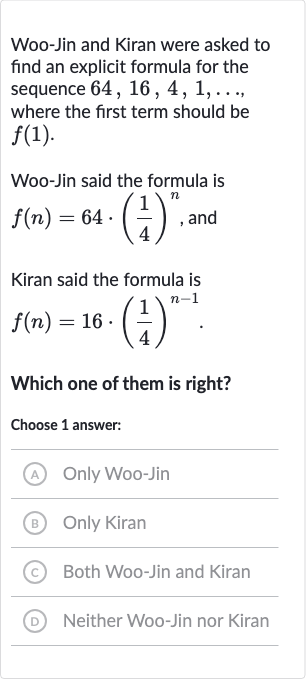AI tutor
Welcome to Bytelearn!
Let’s check out your problem:

Woo-Jin and Kiran were asked to find an explicit formula for the sequence , where the first term should be .Woo-Jin said the formula is , andKiran said the formula is Which one of them is right?Choose answer:(A) Only Woo-Jin(B) Only Kiran(C) Both Woo-Jin and Kiran(D) Neither Woo-Jin nor Kiran
Full solution
Q. Woo-Jin and Kiran were asked to find an explicit formula for the sequence , where the first term should be .Woo-Jin said the formula is , andKiran said the formula is Which one of them is right?Choose answer:(A) Only Woo-Jin(B) Only Kiran(C) Both Woo-Jin and Kiran(D) Neither Woo-Jin nor Kiran
- Question Prompt: The question prompt is: "Which formula correctly represents the sequence ?"
- Sequence Analysis: We have the sequence: This sequence is geometric because each term is obtained by multiplying the previous term by a common ratio.
- Determine First Term and Common Ratio: Determine the first term and the common ratio of the sequence.First term: To find the common ratio, divide the second term by the first term:
- Check Woo-Jin's Formula: Now, let's check Woo-Jin's formula: If we substitute , we get , which is not the first term of the sequence. Therefore, Woo-Jin's formula is incorrect.
- Check Kiran's Formula: Next, let's check Kiran's formula: If we substitute , we get , which is also not the first term of the sequence. Therefore, Kiran's formula is incorrect as well.
- Find Correct Formula: Since both Woo-Jin and Kiran's formulas do not yield the correct first term when , we need to find the correct formula. The correct formula should give us when .The correct formula is , which gives us .
